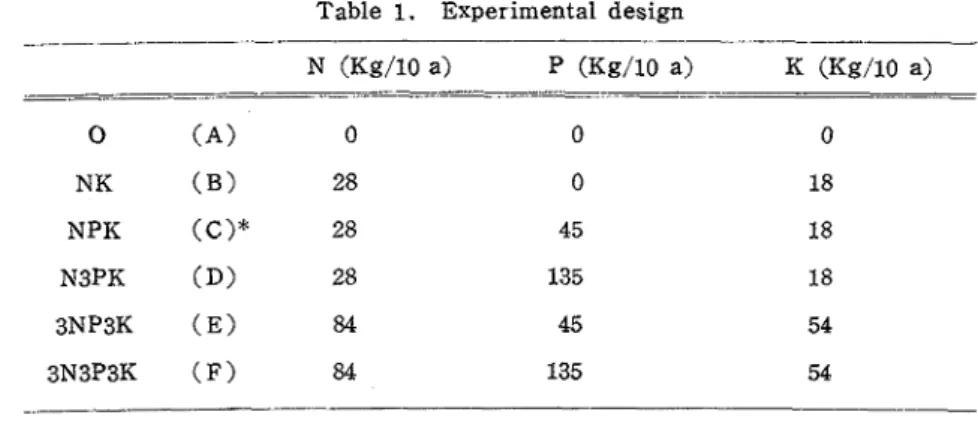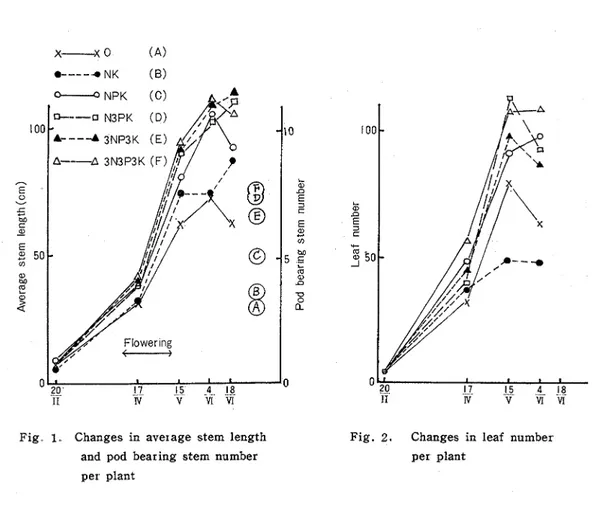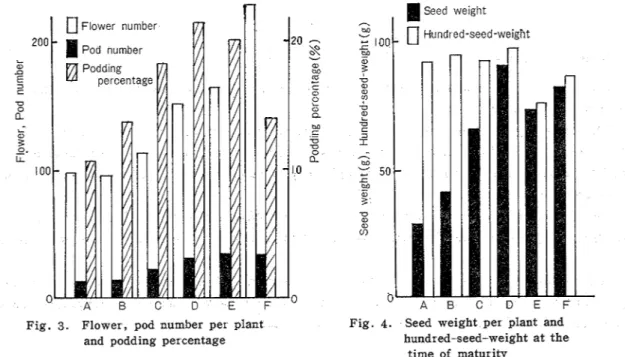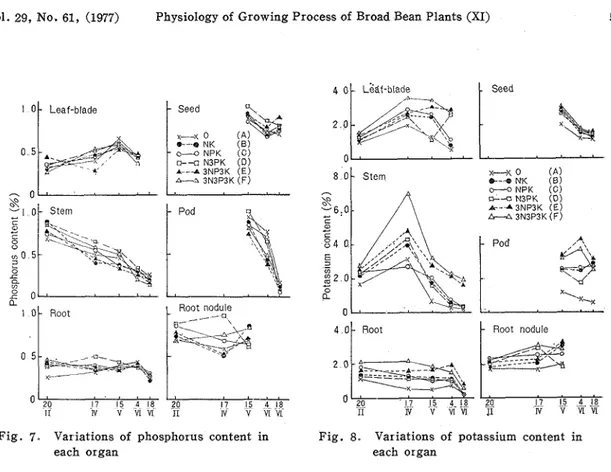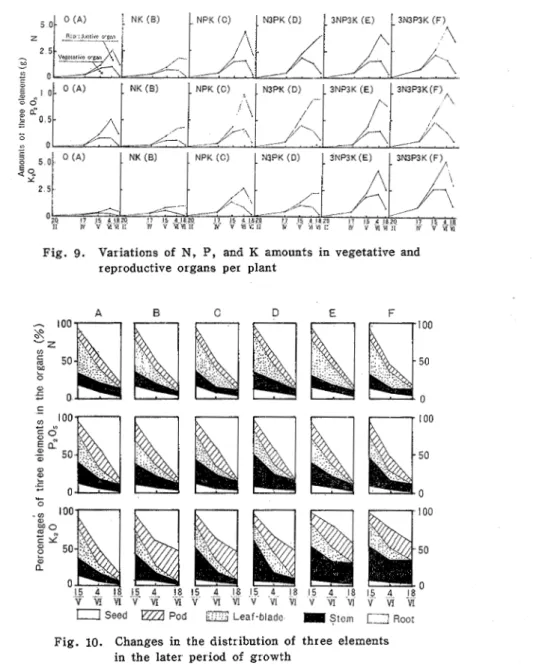Tech. Bull. F a c . A g r
.
K a g a w a Univ. Vol. 29, No. 61, 1-9 1977PHYSIOLOGICAL STUDIES OF T I l E GROWING PROCESS
OF BROAD BEAN PLANTS
XI Effects of Amounts of Fertilizer, especially P
Applications on the Growth and the Seed Production Kiyoshi KOGURE, Koh-ichiro ASANUMA and .Junzaburo NAKA
The effects of amounts of fertilizer, the ratio of applying P to N and K on the growth, and the dry matter production and its distribution to the vegetative and reproductive organs of broad bean plants were studied, using the cultivar "Sanuki-nagasaya" as material. The experiment was conducted with six treatments of NPK (Standard), 0 , NK, N3PK, 3NP3K, and 3N3P3K. The vegetative growth including the development of root nodules and reproductive growth were clearly promoted by dressing of P. Similar results were found with plants receiving much N and K on the development of huge vegetative organs, but the reproductive growth was disturbed.
The contents of three elements in vegetative organs were generally high throughout the vigorous growing period especially in the early to flowering period and that of K was directly high responding to the amount of dressing. And though the amounts of three elements increased after the flowering period, the accumulations of N and P behaved as same as dry matters, different from those of K. The correlation between the maximum amounts of N and P storing in the vegetative organs and seed yields were significant, especially with P.
Judging from the results, it may be pointed out that the active P content in the plant is stable and function a s the limitting factor for the use of N and K elements despite absorbing excess doses in the broad bean plant.
Z$FZK$g,q6Z,E%D&IEE, k h 7 $ K , 9 Y @ t ( & c D I g % 2 ~ ~ & J E ! B J & ~ & . ~ % D ~ F L @ ~ % l G & , s T z & @KWla"??d%??KqL\ T&W L k . %@Kit r,%%$Gli$l &HL\, liTjjEKAL\ T N 5.7, PzO, 7.2, KzO 8.6 Kg/lOa D & H % . R C (NPK) t L., %flE ( o ) , %!J YStie (NK), ?% !J Y@ (NQPK), 353% 9 h !J (3 N P 3 K ) ,
$RE
(3N 3P 3K) D 6 & # 7 ; T B & L , 7 $ D % % & % 3 k m
fi@D&jtm + %,S% L @WM&/EQ, t < K !J Y@D@&K. d: 9 f i & 3 X k . . ~@$@F?J&$$?$iZ%'&&#!f& @ % B R % - k b h k ? ~ i ,
P X .
?J I %?%FB'-b-6 kSRD%B%3djWk.W X % B D ~ ~ ~ X $ % @ ~ ~ @ L
-cHElgil~A
<
, is !J t a t<
K B H ~ ~ D @ ~ I I K # L \ ~ L ~ @ T P ~ ~ ~ B t k . . % k & g % ~ ~ ; ~ ' Q M W E B . U @ R % % ~ 6 t: t: % K , h !J M?DBHf2%E.&LL2&RE&#R# 5 %iSikP& 9 k D K H L , .I&DZ . S % Tta%@J%D%@tjti# L , k . 3 b K . ~ ~ l t ~ & % B K A l + 6 I Y@A 1 CKpgD@k;?$%gt: D B ~ A L ~ , 78 L\@RBiS%i!& b h k . .
2 Kiyoshi KOGURE, Koh-ichiro ASANUMA and Junzaburo NAKA Tech. Bull. Fac. Agr
.
Kagawa Univ.Introduction
TAMAKI et al.'14'showed the balance of N, P , and K nutrient elements had close relations with the assimilation, translocation, and storage of substances, and the requirement for P was the most important in the early stage for the following growth and the function of high molecular compound synthesis in broad bean plants.
The object of this investigation is supplemental to the previous research about the nature of nutrition. The present study is concerned with the effects of amounts of fertilizer and the ratio of phosphorus fertilizer(P) to other fertilizers (N and K) on the uptake of three elements and the meanings for the production and distribution to the vegetative and reproductive organs of dry matter.
Materials and Methods
Broad beans, "Sanuki-nagasaya", were sown in a nursery bed on November 6 and seedlings were transplanted on December 5 as a plant per hill of 30 cm apart in 90 cm rows in the field. The fertilizer applications were made as a basal dressing and the doses were ammonium sulfate, calcium superphosphate, and potassium sulfate. The experimental design is shown in Table 1.
Table 1. Experimental design
NPK ( C ) * 28 45 18
*
NPK (C) : Standard in warm region of JapanPlants were sampled a t five times and the sampling techniques were the same as described in the previous papers'"'12 13'14'. The chemical analyses were made on the dry powdered sam- ples. N was determined by the micro-Kjeldahl method, P was determined, after wet ashing in sulfuric acid, by a molybdenum blue colorimetric method, and K was determined, after extracting with N/5 hydrochloric acid, by atomic absorption spectrophotometry.
Vol. 29, No. 61, (1977) Physiology of Growing Process of Broad Bean plants (XI)
R e s u l t s
Growing Process
Growing status of plants are shown in Figs. 1 to 5. The results were essentially the same as those of the previous ~aper"".
The branching was approximate among six treatments a t first. Stems were delivered from the freezing injury by dressing of phosphorus fertilizer and were more promoted the elongation and the development by large dressing, following increase in number of flowers and normal pods and seeds.
On the contrary, the crop plants which were received much N and K had huge vegetative organs, many flowers, and flowering nodes, but the developments of pod and seed were finally low.
With regard to the development of root system and that of root nodules, though these were promoted by dressing of P , the former was disturbed reversely by large dressing and the latter was retarded by the low ratio of P to N and K application.
Fig 1. Changes in average stem length Fig. 2. Changes in leaf number and pod bearing stem number per plant
4 Kiyoshi KOGURE, Koh-ichiro ASANUMA and Junzaburo NAKA Tech. Bull. Fac. A ~ I . Kagawa Univ.
Seed weight
2
0
Hundred-seed-weight2 100
-
Fig. 3 . Flower, pod number per plant Fig. 4. Seed weight per plant and and podding per centage hundred-seed-weight a t t h e
time of maturity
Chemical Components
The variations of
N,
P , and K content per gram dry weight in each organ are shown in Figs. 6 to 8. The content was generally high in the younger or more active plant organs. Effects of treatment without N application, however, appeared in the later growing period, followed some divergence in percentages of N in the root nodules among six treatments.Vol. 29, No, 61, (1977) Physiology of Growing Process of Broad Bean Plants (XI) - Seed x-x c--.-*
-
0 - 4 D--a b -.d k %$&
0 (A) NK (8) NPK ( C ) N3PK ( 0 ) 3NP3K (E) 3N3P3K (F)x
" + 1 0 Stem 2 c a.P
0 aI 0 - Root - Root nodule _/-a
x- ---
4 a \ ~&if-blade
I
Seed8 0
I
Stem x - 7 x 0 a-* NK (A) ( 8 ) 0-0 NPK (C)0-4 N3PK (0) & - - A 3NP3K (E)
&-A 3N3P3K (F)
4 01. Root
1
Root noduleFig. 7. Variations of phosphorus content in Fig. 8. Variations of potassium content in
each organ each organ
Concerning with P content, it was high in the vegetative organs from the early to the green pod maturing stage, thereafter in the reproductive organs. As compared with N , there was a little divergence in all organs; the percentages of P were somewhat high, responding to the amount of dressing, but there was a reverse tendency in the case of low ratio of P to N and K application.
As for K content, it was high in the vegetative organs in the flowering period. A consid- erable wide divergence in K content was found in the vegetative organs and pods; the per- centages were directly high responding to the amount of dressing.
In seeds, however, contents of three elements were approximate among six treatments and the carbohydrate contents were also almost similar.
Figure 9 shows the variations of amounts of three elements received in the whole plant. Although the increase of these elements was found from flowering to green pod maturing stage in the vegetative organs, the accumulations in the reproductive organs accompanying with the seed maturation. And accumulations of N and P behaved as same as the variations of dry matter, but the tendency of K was contrastive, responding to the amount of dressing ferti- lizer.
Figure 10 shows precisely this connection in the later growing period: as contrast with standard (C), large dressing of K induced excess accumulation in stems and pods. Moreover, either large dressing of P or correlatively low ratio of P to other two elements induced similar per
-
6 Kiyoshi KOGURE, Koh-ichiro ASANUMA and Junzaburo NAKA Tech. Bull. Fac. Agr
.
Kagawa Univ.Fig. 9. Variations of N, P, and K amounts in vegetative and reproductive organs per plant
1
Seeda
Pod i.'Leaf-blade I Stem i_l Root Fig. 10. Changes in the distribution of three elementsin the later. period of growth
Discussion
Many investigations have been reported on the manurial trials with broad beans (Vzcia ,faba), but there have been found almost no conclusive studies. TAMAKI et al." gave reason for the response of the crop for fertilizers on the growth and yield greatly with local soil or cultural media and possibly climatic conditions. The authors pointed out that the balance of N , P, and K contents absorbed in plants was one of the key of this problem in the previous paper04).
In contrast with the treatment of non-dressing fertilizer, the positive effects on the growth of crop plants were clearly recognized with the application of every these nutrient elements,
Vol. 29, No. 61, (1977) Physiology of Growing Process of Broad Bean Plants (XI) 7 especially by dressing with phosphorus fertilizer. The absorption of three elements which was mostly taken during the vegetative and reproductive growth progressed together, however, was not always related to the physiolgical status. Thereby the different growth of the vege- tative and reproductive organs followed inducing the divergence of seed yield among six treat- ments.
Concerning with the influence of P on vegetative growth in the early growing period in winter, it contributed toward the enhancement for development of root nodu~es(~"~)and the pre. vention against death of some stems by cold damage(l6)and the accelerating effect on dry matter accumulation. ~ ~ M E ~ ( l ) s t a t e d that the critical period for P of broad bean plants was be. tween 3rd and 9th week following the planting. He also reported that if absorbed sufficient
P in this period the plant developed and the seed produced normally. On the other hand, P absorbed continuously throughout the whole growing period and contributed to the plant growth and seed development were also recognized('' 2 9 3'
"
99.10).
Anyhow, P migth be con- tributed toward the assimilation, translocation, and utilization of assimilates via the promotion of root growth(g' 14'15). With regard to root nodules, HAMDI et al.")reported the root nodule ac- tivity was more promoted by applying P with N than without N fertilizer, following vigorous plant growth and much grain yield of broad beans.As with the influence of large dressing with N and K, plants, if absorbed considerable amount of P, grew with huge vegetative organs. With regard to the growth of reproductive organs, however, although the extent of flowering nodes was fairly broad owing to elevating the node order, the podding and the development of pod and seed were inferior to standard or usual dressing of fertilizer. Different effects of large N and K dressing on the growth and seed yield(3 ' ' ' 7 ' ')and the chemical
component^'^'
' ' l O ) s h ~ ~ e d that out of these doses absorbed how much portion had a hand in the physiological effect as the active N, P, and K in plant organs.x--x Whole plant 0----0Vegetat ~ v e organ *-• Reproduct ~ v e organ
Fig. 11. Changes in the dry matter productivity in vegetative and reproductive organs
8 Kiyoshi KOGURE, Koh-ichiro ASANUMA and Junzaburo NAKA Tech. Bull. Fac. Agr
.
Kagawa Univ.Maximum amounts of three elements in vegetative organs (g plant) Fig. 12. Correlations between the maximum amounts of three elements
storing in vegetative organs and seeds
Thus, the balance of such active macro nutrient elements seemed to control the development of vegetative and reproductive organs. Figure 11 shows the dry matter productivity or i n - creasing behavior of dry weight in both organs per plant per day. Excess doses of N and K
or correlatively low ratio of P to N and K revealed this tendency described above. Moreover, the authors pointed out in the previous papers(ll"*) that stems, roots, and laters pods played the role as a temporary storing organs for the chemical components in seeds. With these assumptions, the correlation between the maximum amounts of three elements storing in the vegetative organs and seed yield per plant are shown in Fig. 12. In contrast with N and P , excess accumulation of K in the vegetative organs did not connected directly to the increase of seed production. The dressing effect of P , however, was clearly and peculiarly recognized on the accumulation of both N and K.
Therefore, it seems that excess absorption of N and K disturbs the normal growth of vege- tative and reproductive organs, and still holds on this tendency independently of overabundant applying of P. Accordingly, it is clear that the phosphorus fertilizer is the most important for the vegetative growth and seed development and the active P contents in the plant is stable and function as the limitting factor for the use of other N and K nutrient elements in broad bean plants.
Literature Cited
( 1 ) AHMED, M . B. : The effect of the presence and absence of phosphorus a t different peri- ods of growth of Vzcza faba, Indzan J . agrzc. Sci., 28, 43-56 (1958).
( 2 ) AIHARA, S. : On the absorption status of fertilizers in broad bean, Tech. Bull. Mzyagz Prefectural Agr
.
Ex$. S t a . , (25), 31-36 (1959), (in Japanese).( 3 ) BAINS, K. S. : Effect of applied nutrients on soil fertility, chemical composition, and yield of field beans, Indzan J. Agron., 12, 200-206 (1967).
( 4 ) GUKOVA, M M, BOGOMOLOVA, R. I : The
effect of conditions of nutrition on growth and accumulation of N in fodder beans in a mixed crop with maize, Dokl. Akad. Nauk S S S R , 149, 725-727 (1963) ; cf
.
Fzeld Crop Abstr, 16, 235 (1963).(5) HAMDI, H, TAHA, S., EL-DAMAIY, A., EL-
SHERIF, A : The effect of bacterial inocu- lation and phosphatic fertilization on some legumes in a sandy loam soil of the U. A. R ,
J. Sozl Scz. U " A. R , 6, 1 - 1 6 (1966)
( 6 ) HONG, J. U. : Influence of increasing potash applications on yield, quality and enzyme content of rye, barley and field beans, Bayer
Vol. 29, No. 61, (1977) Physiology of Growing Process of Broad Bean Plants (XI) 9 landw
.
Jahrb., 37, 729-734 (1960) ; cf FzeldCrop Abstr
,
15, 190 (1962).( 7 ) MCEWEN, J. : Fertilizer nitrogen and growth regulators for field beans (Vzcza faba, L ),
I. The effects of seed bed applications of large dressings of fertilizer nitrogen and the residual effects on following winter wheat, J. agrzc.Scz
,
74,61-66 (1970).( 8 ) MCEWEN, J. : Fertilizer nitrogen and growth regulators for field beans (Vzcza faba, L.), 11. The effects of large dressings of ferti- lizer nitrogen, single and split applications, and growth regulators, J. agrzc. Scz
,
74,67- 72 (1970).( 9 ) PERSANOV, V. M , ANDREEVA, T F. : Effect of the duration of P deficiency on translo- cation and utilization of assimilates in relation to plant growth and productivity, Fzzzologzya Rast., 17, 1175--1181 (1970); cf
.
Fzeld Crop Abstr
,
24, 491-492 (1971). (10) SHATILOV, I. S.: Utilization by Vzcza fabaof P and K from dernopodzolic soil, Dokl. mosk. se1'-khoz. Akad. K. A. Tzmzr yazeva, (159), 27-31 (1970); cf. Herb. Abstr, 41,
304 (1971).
(11) TAMAKI, K., NAKA, J. : Physiological studies of the growing process of broad bean plants, I. On the variations of chemical components in various organs of the tops during the growing period, Tech. Bull. Fac. Agr
.
Kagawa Univ., 11, 13-18 (1959), (in Japa- nese).
(12) TAMAKI, K., NAKA, J. : Physiological studies of the growing process of broad bean plants, 11. On the relations between the variations of chemical components in the tops and roots during the growing period, Proc. Crop Scz
.
Japan, 27, 97-98 (1958), (in Japanese).
(13) TAMAKI, K., NAKA, J. : Physiological studiesof the growing process of broad bean plants, 111. Effects of soil moisture on the growth and the variations of chemical components in the various organs, Tech. Bull. Fac Agr. Kagawa Unzv., 22, 73--82 (1971).
(14) TAMAKI, K., NAKA, J. : Physiological studies of the growing pr ocess of broad bean plants, IV. Effects of N, P, and K nutrient elements on the growth and chemical components in the various organs, Tech. Bull. Fac. Agr
.
Kagawa Unzu., 23, 2-10 (1971).(15) WILKINSON, J. : Some aspects of phospate nutrition in the root system of broad bean (Vzcza faba), J Exp. Bot., 7,290-295 (1956). (16) YOSHIMURA, S , MASAKI, E , YAMASAKI, O., KOTOI A N I , M. : On the adequate amount of phosphate and potassium applied on the cul. tivar Issun Soramame bean (Vzcza Faba), Bull. Osaka Agr .Resarch Center, ( 4 ) , 63- 73 (1967), (in Japanese).
